Abstract
The effect of ethanol on N-demethylation of aminopyrine in rat liver slices and in the microsomal fraction and on microsomal hydroxylation of pentobarbital and aniline was studied. With liver slices N-demethylation of aminopyrine was stimulated by 35–40% at low ethanol concentrations (2mm), whereas no stimulation occurred at high concentrations (100mm). With the liver microsomal fraction, an inhibitory effect was observed only at high ethanol concentrations (100mm). This was also observed with the other drugs studied. In agreement with these results, only at a high concentration did ethanol interfere with the binding of drug substrates to cytochrome P-450. Further, as previously reported, ethanol produced a reverse type I spectral change when added to the liver microsomal fraction. Evidence that this spectral change is due to removal of substrate, endogenously bound to cytochrome P-450, is reported. A dual effect of ethanol is assumed to explain the present findings; in liver slices, at a low ethanol concentration, the enhanced rate of drug oxidation is the result of an increased NADH concentration, whereas the inhibitory effect observed with the microsomal fraction at high ethanol concentration is due to the interference by ethanol with the binding of drug substrates to cytochrome P-450.
Full text
PDF
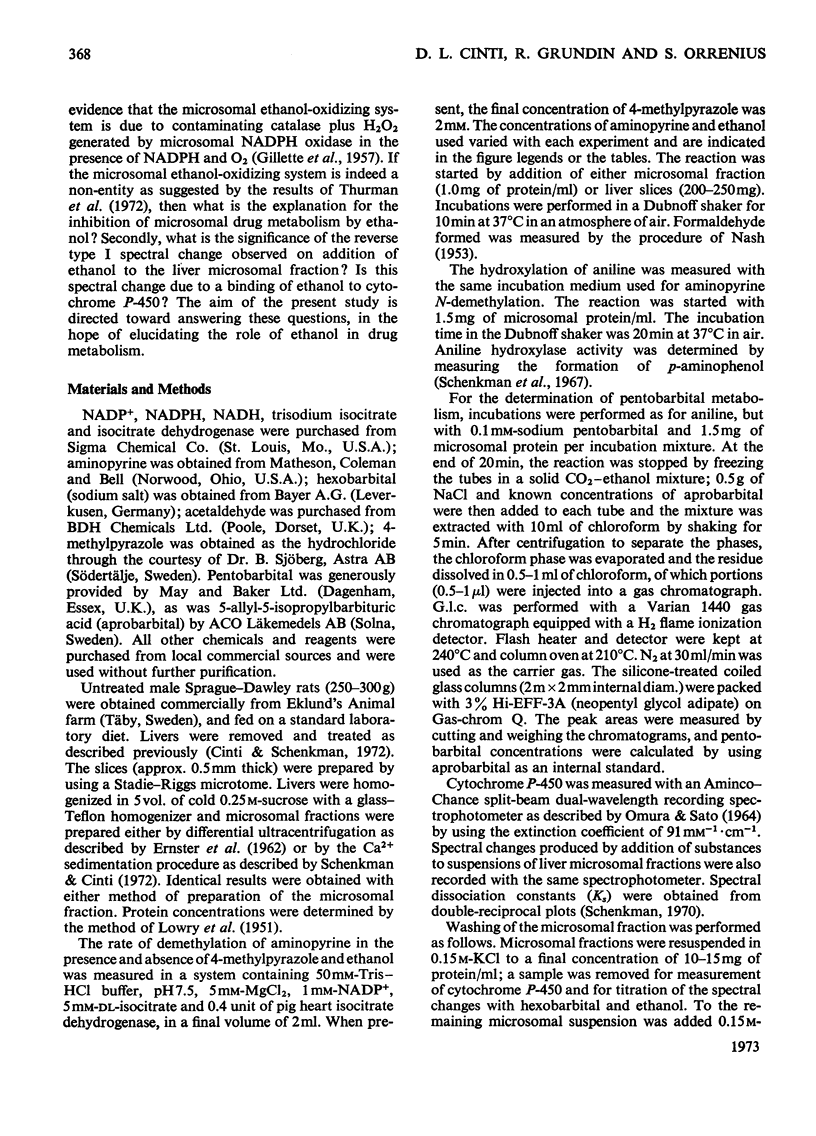
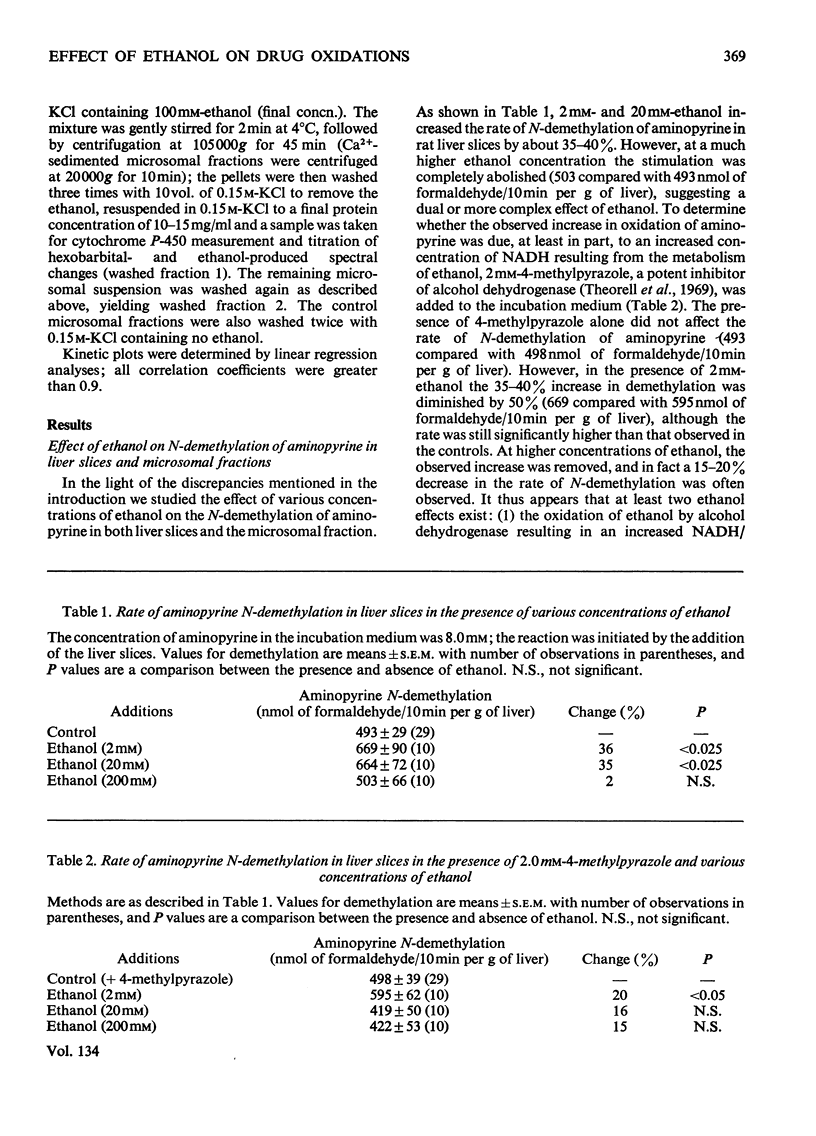



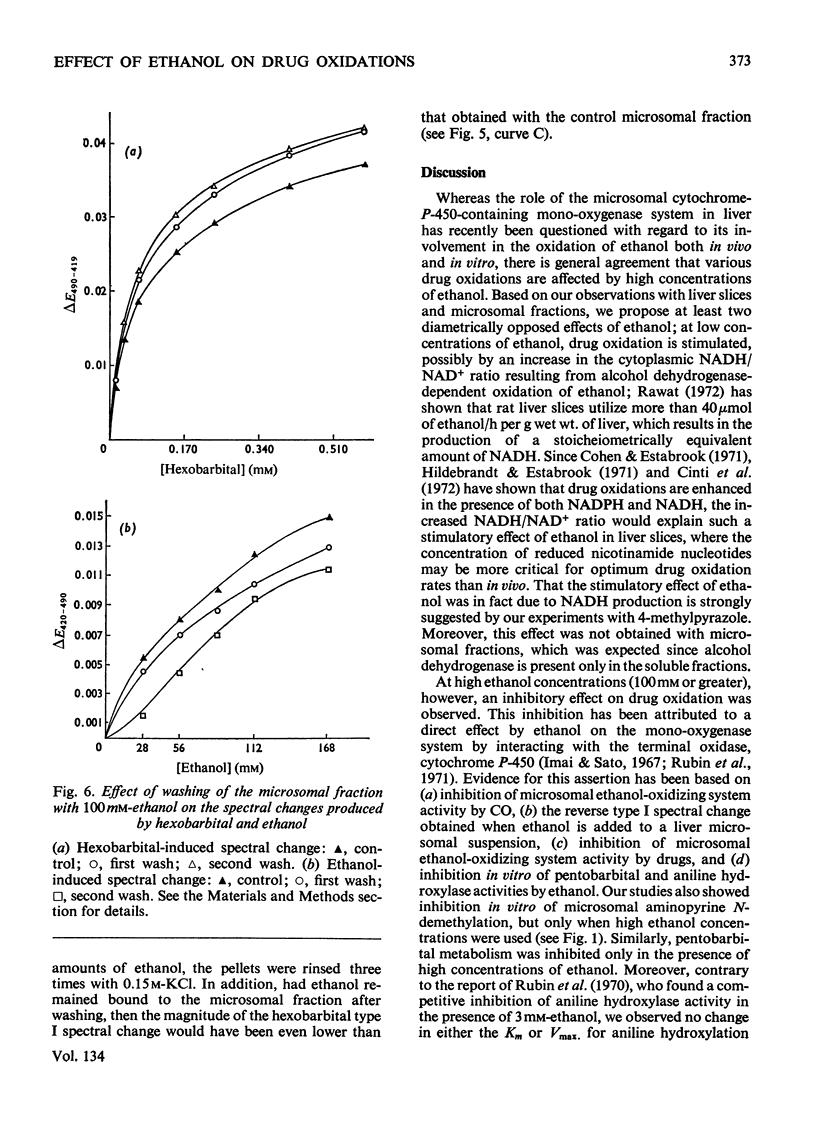
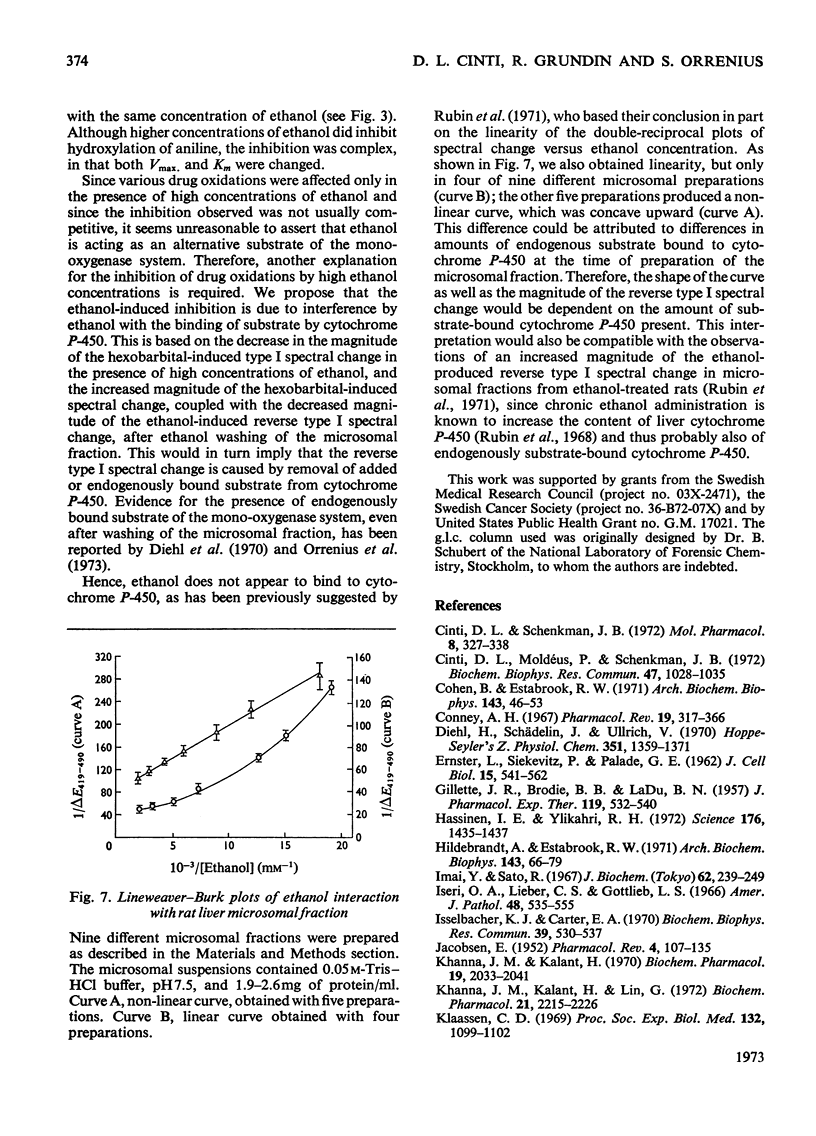
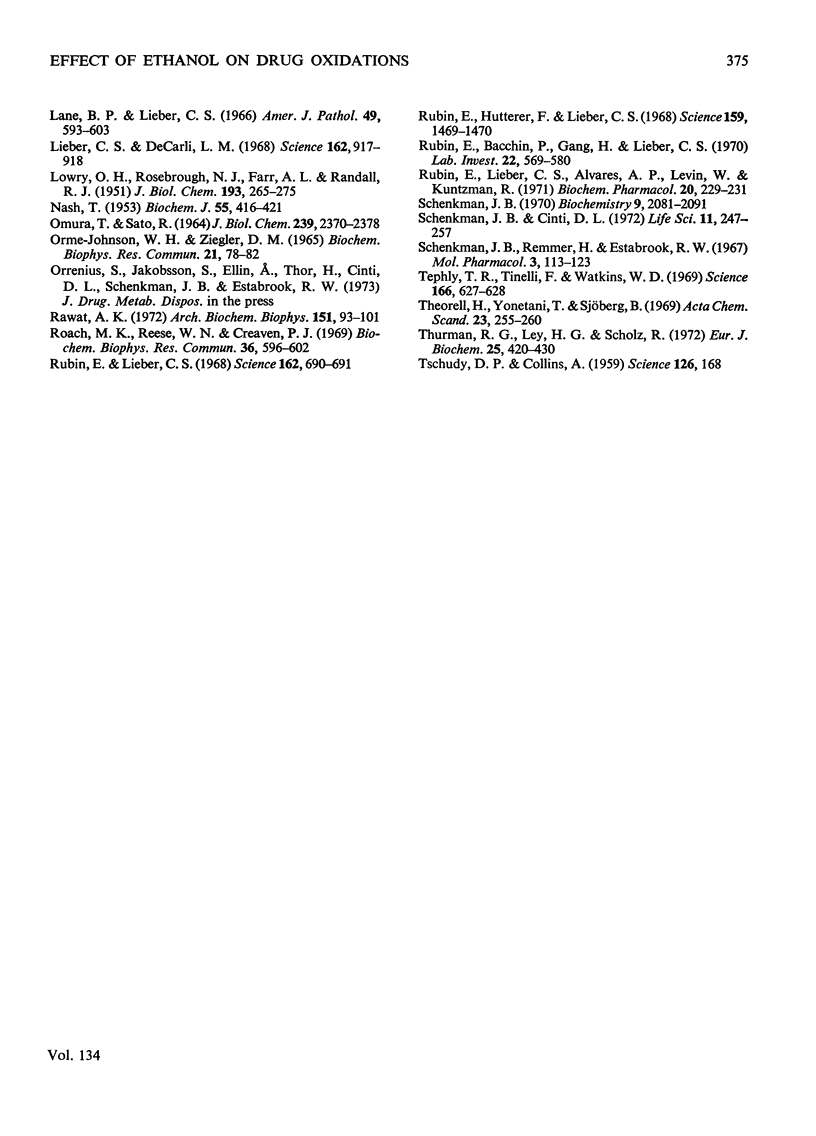
Selected References
These references are in PubMed. This may not be the complete list of references from this article.
- Cinti D. L., Moldeus P., Schenkman J. B. The role of the mitochondria in rat liver mixed function oxidation reactions. Biochem Biophys Res Commun. 1972 Jun 9;47(5):1028–1035. doi: 10.1016/0006-291x(72)90936-9. [DOI] [PubMed] [Google Scholar]
- Cinti D. L., Schenkman J. B. Hepatic organelle interaction. I. Spectral investigation during drug biotransformation. Mol Pharmacol. 1972 May;8(3):327–338. [PubMed] [Google Scholar]
- Cohen B. S., Estabrook R. W. Microsomal electron transport reactions. II. The use of reduced triphosphopyridine nucleotide and-or reduced diphosphopyridine nucleotide for the oxidative N-demethylation of aminopyrine and other drug substrates. Arch Biochem Biophys. 1971 Mar;143(1):46–53. doi: 10.1016/0003-9861(71)90184-6. [DOI] [PubMed] [Google Scholar]
- Conney A. H. Pharmacological implications of microsomal enzyme induction. Pharmacol Rev. 1967 Sep;19(3):317–366. [PubMed] [Google Scholar]
- Diehl H., Schädelin J., Ullrich V. Studies on the kinetics of cytochrome P-450 reduction in rat liver microsomes. Hoppe Seylers Z Physiol Chem. 1970 Nov;351(11):1359–1371. doi: 10.1515/bchm2.1970.351.2.1359. [DOI] [PubMed] [Google Scholar]
- GILLETTE J. R., BRODIE B. B., LA DU B. N. The oxidation of drugs by liver microsomes: on the role of TPNH and oxygen. J Pharmacol Exp Ther. 1957 Apr;119(4):532–540. [PubMed] [Google Scholar]
- Hassinen I. E., Ylikahri R. H. Mixed function oxidase and ethanol metabolism in perfused rat liver. Science. 1972 Jun 30;176(4042):1435–1437. doi: 10.1126/science.176.4042.1435. [DOI] [PubMed] [Google Scholar]
- Hildebrandt A., Estabrook R. W. Evidence for the participation of cytochrome b 5 in hepatic microsomal mixed-function oxidation reactions. Arch Biochem Biophys. 1971 Mar;143(1):66–79. doi: 10.1016/0003-9861(71)90186-x. [DOI] [PubMed] [Google Scholar]
- Imai Y., Sato R. Studies on the substrate interactions with P-450 in drug hydroxylation by liver microsomes. J Biochem. 1967 Aug;62(2):239–249. doi: 10.1093/oxfordjournals.jbchem.a128654. [DOI] [PubMed] [Google Scholar]
- Iseri O. A., Lieber C. S., Gottlieb L. S. The ultrastructure of fatty liver induced by prolonged ethanol ingestion. Am J Pathol. 1966 Apr;48(4):535–555. [PMC free article] [PubMed] [Google Scholar]
- Isselbacher K. J., Carter E. A. Ethanol oxidation by liver microsomes: evidence against a separate and distinct enzyme system. Biochem Biophys Res Commun. 1970 May 11;39(3):530–537. doi: 10.1016/0006-291x(70)90610-8. [DOI] [PubMed] [Google Scholar]
- JACOBSEN E. The metabolism of ethyl alcohol. Pharmacol Rev. 1952 Jun;4(2):107–135. [PubMed] [Google Scholar]
- Khanna J. M., Kalant H. Effect of inhibitors and inducers of drug metabolism on ethanol metabolism in vivo. Biochem Pharmacol. 1970 Jun;19(6):2033–2041. doi: 10.1016/0006-2952(70)90300-x. [DOI] [PubMed] [Google Scholar]
- Khanna J. M., Kalant H., Lin G. Significance in vivo of the increase in microsomal ethanol-oxidizing system after chronic administration of ethanol, phenobarbital and chlorcyclizine. Biochem Pharmacol. 1972 Aug 15;21(16):2215–2226. doi: 10.1016/0006-2952(72)90037-8. [DOI] [PubMed] [Google Scholar]
- Klaassen C. D. Ethanol metabolism in rats after microsomal metabolizing enzyme induction. Proc Soc Exp Biol Med. 1969 Dec;132(3):1099–1102. doi: 10.3181/00379727-132-34374. [DOI] [PubMed] [Google Scholar]
- LOWRY O. H., ROSEBROUGH N. J., FARR A. L., RANDALL R. J. Protein measurement with the Folin phenol reagent. J Biol Chem. 1951 Nov;193(1):265–275. [PubMed] [Google Scholar]
- Lane B. P., Lieber C. S. Ultrastructural alterations in human hepatocytes following ingestion of ethanol with adequate diets. Am J Pathol. 1966 Oct;49(4):593–603. [PMC free article] [PubMed] [Google Scholar]
- Lieber C. S., DeCarli L. M. Ethanol oxidation by hepatic microsomes: adaptive increase after ethanol feeding. Science. 1968 Nov 22;162(3856):917–918. doi: 10.1126/science.162.3856.917. [DOI] [PubMed] [Google Scholar]
- NASH T. The colorimetric estimation of formaldehyde by means of the Hantzsch reaction. Biochem J. 1953 Oct;55(3):416–421. doi: 10.1042/bj0550416. [DOI] [PMC free article] [PubMed] [Google Scholar]
- OMURA T., SATO R. THE CARBON MONOXIDE-BINDING PIGMENT OF LIVER MICROSOMES. I. EVIDENCE FOR ITS HEMOPROTEIN NATURE. J Biol Chem. 1964 Jul;239:2370–2378. [PubMed] [Google Scholar]
- Orme-Johnson W. H., Ziegler D. M. Alcohol mixed function. Oxidase activity of mammalian liver microsomes. Biochem Biophys Res Commun. 1965 Oct 8;21(1):78–82. doi: 10.1016/0006-291x(65)90429-8. [DOI] [PubMed] [Google Scholar]
- Rawat A. K. The redox-state in relation to ethanol metabolism by rat and guinea pig liver in vitro. Arch Biochem Biophys. 1972 Jul;151(1):93–101. doi: 10.1016/0003-9861(72)90477-8. [DOI] [PubMed] [Google Scholar]
- Roach M. K., Reese W. N., Jr, Creaven P. J. Ethanol oxidation in the microsomal fraction of rat liver. Biochem Biophys Res Commun. 1969 Aug 15;36(4):596–602. doi: 10.1016/0006-291x(69)90346-5. [DOI] [PubMed] [Google Scholar]
- Rubin E., Bacchin P., Gang H., Lieber C. S. Induction and inhibition of hepatic microsomal and mitochondrial enzymes by ethanol. Lab Invest. 1970 Jun;22(6):569–580. [PubMed] [Google Scholar]
- Rubin E., Hutterer F., Lieber C. S. Ethanol increases hepatic smooth endoplasmic reticulum and drug-metabolizing enzymes. Science. 1968 Mar 29;159(3822):1469–1470. doi: 10.1126/science.159.3822.1469. [DOI] [PubMed] [Google Scholar]
- Rubin E., Lieber C. S., Alvares A. P., Levin W., Kuntzman R. Ethanol binding to hepatic microsomes. Its increase by ethanol consumption. Biochem Pharmacol. 1971 Jan;20(1):229–231. doi: 10.1016/0006-2952(71)90489-8. [DOI] [PubMed] [Google Scholar]
- Rubin E., Lieber C. S. Hepatic microsomal enzymes in man and rat: induction and inhibition by ethanol. Science. 1968 Nov 8;162(3854):690–691. doi: 10.1126/science.162.3854.690. [DOI] [PubMed] [Google Scholar]
- Schenkman J. B., Remmer H., Estabrook R. W. Spectral studies of drug interaction with hepatic microsomal cytochrome. Mol Pharmacol. 1967 Mar;3(2):113–123. [PubMed] [Google Scholar]
- Schenkman J. B. Studies on the nature of the type I and type II spectral changes in liver microsomes. Biochemistry. 1970 May 12;9(10):2081–2091. doi: 10.1021/bi00812a009. [DOI] [PubMed] [Google Scholar]
- TSCHUDY D. P., COLLINS A. Effect of 3-amino-1, 2, 4-triazole on delta-amino-levulinic acid dehydrase activity. Science. 1957 Jul 26;126(3265):168–168. doi: 10.1126/science.126.3265.168. [DOI] [PubMed] [Google Scholar]
- Tephly T. R., Tinelli F., Watkins W. D. Alcohol metabolism: role of microsomal oxidation in vivo. Science. 1969 Oct 31;166(3905):627–628. doi: 10.1126/science.166.3905.627. [DOI] [PubMed] [Google Scholar]
- Theorell H., Yonetani T., Sjöberg B. On the effects of some heterocyclic compounds on the enzymic activity of liver alcohol dehydrogenase. Acta Chem Scand. 1969;23(1):255–260. doi: 10.3891/acta.chem.scand.23-0255. [DOI] [PubMed] [Google Scholar]
- Thurman R. G., Ley H. G., Scholz R. Hepatic microsomal ethanol oxidation. Hydrogen peroxide formation and the role of catalase. Eur J Biochem. 1972 Feb;25(3):420–430. doi: 10.1111/j.1432-1033.1972.tb01711.x. [DOI] [PubMed] [Google Scholar]


